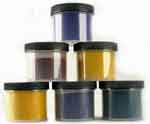I have lots of Cushing's old union dye - what can expect if I attempt to dye wool with the union dye and citric acid?
Name: Brenda
—ADVERTISEMENTS—

Lanaset Dyes are among the very best dyes for hand-dyeing wool, silk, angora, mohair, and most nylons. You will also need: citric acid, sodium acetate, Glauber salt, Albegal SET, and Synthrapol.
Buy from
Paradise Fibers
The acid dye in union dye, which is another name for all-purpose dye, will work on wool. In fact, it might be the exact same dye that's in Cushing acid dye. The direct dye in the union dye mix will mostly wash out; before washing out, it's possible that it will mislead you a little as to the color of your dye, depending on the formula. Keep in mind that, since there is a lot of waste in the form of the direct dye, you will need to use a much larger amount of dye powder than if you use pure acid dye. Don't measure the union dye by weight or by volume, but instead by the package; unless the writing on the package indicates otherwise, you can assume that one package is supposed to dye one pound of fiber (weighed when dry). Use half a package for half a pound of wool, etc.
I don't know how much acid (if any) may be included in the formula already; there isn't enough acid included for best results in dyeing wool in the Rit or Tintex brands of all-purpose dye, so it's probably a good idea for you to add it. The directions for using Cushing's Acid Dyes [PDF] suggest using one cup of vinegar per pound of fiber. That's similar to using about twenty milliliters (four teaspoons) of citric acid.
The acid dye in all-purpose mixtures such as Cushing's old union dye, like the dye used in Cushing's acid dye, is the type of dye known as strong acid dye, or as acid leveling dye. (See "Leveling Acid Dyes".) It has lower washfastness than other types of acid dye, but is very good at leveling (producing a single solid color). It requires a lower pH than other types of acid dye, so it needs more vinegar or citric acid.
Is there any sort of date anywhere on the package? It looks like Cushing's switch from making union dye to making separate acid and direct dyes may have occurred in 1997 or shortly before, because there's an W. Cushing advertisement in a 1997 volume of the Surface Design Journal that describes the acid dyes and direct dyes as "NEW!". It's important to have some idea of how old your dyes are, because all-purpose dyes packaged before around 1980 are likely to contain benzidine-based dyes, which are known carcinogens and therefore much more dangerous to work with than most other dyes. (See, for example, my blog post about Old Putnam Dyes and another post about benzidine in dyes.) All-purpose dyes sold in the late 1980s and in the 1990s are probably safe, though you should always take safety precautions with any dye, just in case. Wear waterproof gloves, don't use the same pot for dyeing as for cooking, and avoid breathing dye powder.
When you run out of your Cushing dyes, you will find that you can order other types of acid dyes much more economically; these other dyes also have other desirable properties, such as being more resistant to fading when washed. One 1/3-ounce package of Cushing Perfection acid dye, which costs about three dollars, will color one pound of wool. (Use more dye for darker colors, less dye for paler colors.) The cost for enough Lanaset dyes to color one pound of wool is less than a dollar, on average (some colors cost more), even though Lanaset dyes are considered expensive and are extremely high in quality. ProChem's Washfast Acid Dyes cost a little more than half as much as Lanaset dyes, per pound of fiber, but most of them are more washfast than the type of acid dye found in the Cushing dyes. (See the chart I posted in the Dye Forum, "Comparison of Dye Costs".)
(Please help support this web site. Thank you.)
Posted: Tuesday - May 08, 2012 at 01:19 PM
Follow this blog on twitter here.
- Top of this blog -
- FAQ -
- The Dye Forum -
- How to Tie Dye - How to Batik -
- Books - Toys - Plants -
More in this category:
- -
Total entries in this category:
Published On: Aug 29, 2012 02:49 PM